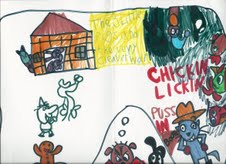INTEGRATIVE ARTS and PLAY
Who for:
All professionals including Parent Support Workers
Session duration:
1. One Day Training 10 – 3.30: Reflective Listening and Reflective Play
2. Two-Hour twilight sessions 4.30 – 6.30: Additional Integrative Arts skills
Skills:
1. Reflective Listening and Reflective Play – Basic Skills.
2. Additional expressive arts skills integrating creative journal with:
collage/maskwork/visioning
clay/mixed media
sandplay
matwork
Optional:
movement/dance
rhythm/drum
story improvisation skills
group collage and vision coaching
Based on the work of the Play Team Association in West Sussex, the core of the training is in Reflective Listening and Reflective Play, giving children non judgemental attention through reflective listening and play sessions. Their work also includes creative/expressive arts faciliation for adults in which integrative arts activities include reflective listening and self counselling Creative Journal.
CASE HISTORIES of HIGH VISUAL THINKERS and MULTIPLE INTELLIGENCE
High Visual children do not easily process auditory language but are very talented in visual skills. Are they ‘disabled learners’ with autism, ADHD, Dyslexia or other ‘disabilities’ or have we yet to understand what Howard Garnder called the ‘multiple intelligences’ that children present?
The work of Dr Cheri Florence, a speech therapist, has challenged our views on ‘learning disabilities’. She began rethinking language therapy when her silent son, Whitney, showed obvious signs of alert observation visually, and sequencing memories of what he saw in books. He had been diagnosed as autistic. She devised a visual-spatial home education curriculum which included picture stories of familiar domestic experiences and shared family activities, drama, music, dance and other collaborative, active ways of developing communication. His control of verbal language developed quickly, and his self esteem remained buoyant as his family connected with his high visual style of thinking. Whitney is now an engineer and dramatist, fully expressive and socially comfortable.
Go to her site to watch videos from ‘Brain Engineering Lab’ of children learning:
http://www.ebrainlabs.com/vvs.do
Sam is another young man who was highly visual as a learner, and who flourished with a drama-lead home education curriculum. A talented drawer, he developed IT graphic skills, achieved a BA and became an animator. His curriculum was largely creative narrative, through puppets, home education, storyboards, IT processing and music. His teacher was trained in ‘Non Directive Play’ and performance improvisation, as well as being a certified teacher and PhD graduate.
As a young film maker, he devised and produced many home videos which presented themes of social dilemmas, such as teenage behaviour, old men, racial differences, teachers and students, and health problems. Here is one about moving from boyhood to adulthood: ‘Bearded Boy’ is played by members of his family and myself, all with some performance art training, and it is entirely improvised along the given theme.
The following video includes Sam who is 7 yrs old and Bob Filling a character he devised as a foil for his puppet character ‘Ponty the Pig’. Ponty is a naughty, loud, disobedient fellow who resists being told a story, which makes Bob pretty mad. The experience of ‘being taught’ was for Sam fraught with conflictual interests, and he avoided reading standard reading books at school. However, he was very driven by the idea of being an author and creator of narratives.
Sam interpreted all children’s stories in his own ‘visual words’. Here is his version of ‘Chicken Licken’.
At school Sam wrote a series of stories in nine exercise books, fully illustrated, punctuated and given the conventions of bookish presentation (title, author, ending). Here are the first two pages of ‘Dinosaurs’. The bold, artistic use of colour spoke of the messages of his pictures and self confident hues, which were mirroring the genre of children’s stories, and for him sending a message of defiance for the routine and boredom he found in the classroom. The literacy environment at school had evidently had a profound effect on his self image as visual storyteller and commentator on social conventions
For more about child-centred approaches and the ‘High Visual’ learner, download this flip-book, designed for those who are ‘Picture Thinkers’, dyslexics, and highly visual in their lives. It is a converted photo-book and consists of text boxes of quotes, images, activities and philosophical questions:
‘Playful Pictures’ flip _book2014
‘Playful Pictures’ flip-book is a converted photobook created by Cliacreations and Swanimation, offering images, texts, and links for child-directed learning approaches, case study material in full glossy colour, with activities, examples and checklists. It encourages the reader to use both sides of the brain to process the central message that child-directed learning can be efficient, organic, motivated by powerful curiosity and playful imagination, and easily facilitated within the structure of the National Curriculum of England and Wales. All educational initiatives displayed are currently being used in UK schools, are regularly inspected by OFSTED, and have been proven to support childrens’ development of literacy and numeracy skills through an individualised learning styles. This book sets out to demonstrate that basic facilitation skills are accessible to teachers and parents, the outcomes in children’s work are colourful, detailed and inspiring, and the essential act of sharing knowledge between children themselves can be a highly effective ‘self assessment’ tool for language learning, provided a teacher can record, display and reflect what is being learned. It is important, we believe, that the ‘Hundred Languages of Children’ be celebrated, crafted to engage all learners in the creation of ‘common knowledge’, and integrated into the multi-literacy/language communication styles of the age in which we live.
To order your own glossy, hardback version of ‘PLAYFUL PICTURES’ which allows you leisure, and the additional sensory pleasures of turning the glossy, full colour pages with your friends and children, contact me.
Links to other organisations offering child direction learning which integrate the arts:





Pingback: Child Directed learning | Clia CoachingClia Coaching